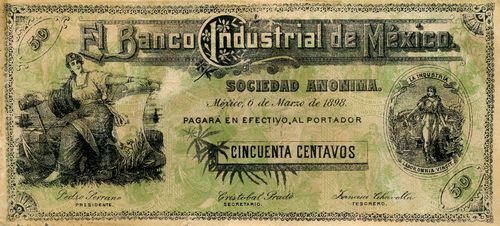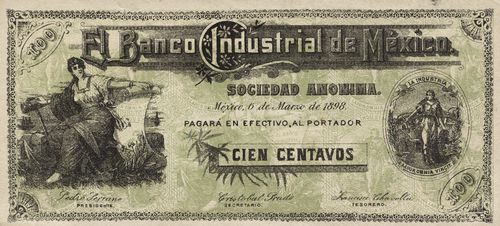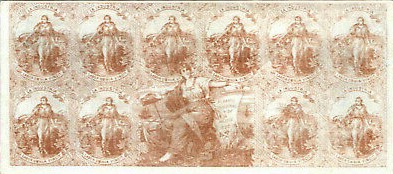El Banco Industrial de México
Despite the imposing title these notes, if issued, would not have been banknotes but used to pay the workers of a firm that all but monopolised the processing and sale of pork products in Mexico City. The reasons for coming to this conclusion are
(a) the absence of any reference to the 'bank' in official documents or the press,
(b) the signatories are Presidente, Secretario and Tesorero but not an Interventor,
(c) the relatively low denominations of the known examples (50c and $1), and
(d) the fact that the Ley General of 1897 prohibited banknotes of denominations smaller than five pesos, as well as
(e) at least two of the signatories, Pedro Serrano y Castillo and Francisco Chavolla, were involved in meat processing, and
(f) the seal on the right of the faces and on the reverses is of 'LA INDUSTRIA' with the motto 'LABOR OMNIA VINCIT' ('Work conquers all'). In December 1897 the Secretaría de Fomento granted Pedro Serrano an exclusive trademark for his 'La Industria' productsLa Voz de México, 31 December 1897.
 M220 50c Banco Industrial de México
M220 50c Banco Industrial de México

 M221 $1 Banco Industrial de México
M221 $1 Banco Industrial de México
This pair of notes carry the date 6 March 1898. However, eleven days later, on 17 March, the enormous packaging plant in San Lázaro (where not only were the pigs slaughtered and turned into pork products, but byproducts such as soap and tallow and paraffin candles were produced) burnt downLa Voz de México, 18 March 1898. The loss was calculated at $300,000El Popular, 18 March 1898. So Serrano might have been otherwise occupied. A new Casa Empacadora at 9a calle de Noncalco was opened to great fanfare on 9 OctoberLa Voz de México, 11 October 1898: El Tiempo, Año XVI, Núm. 4519, 13 October 1898.
They have the printed signatures of Pedro Serrano as Presidente, Cristobal Prado as Secretario and Francisco Chavolla as Tesorero.
|
Pedro Serrano y Castillo was born in 1826 in the town of Calimaya, Estado de México. His father had worked as a pork butcher (tocinero) in Mexico City and may have rented a shop from an ecclesiastical institution in the late colonial period. Pedro did not inherit the business, but he did maintain connections with the informal guild of the early republic. His mentor, Francisco Chavollo, owner of the Tocinería "El Chivato" (The Big Goat), probably helped him get started in the business in the 1850s. Serrano also learned to use the liberal regime to his advantage, particularly the Ley Lerdo disentailing Church property. On 23 September 1856, just three months after the passage of the law, he successfully filed suit to purchase his first shop from the Mercedarian Colegio de Belén. He rented another shop about the same time, and by 1870, he was a leader in the campaign demanding indemnification for the removal of pigpens from Mexico City. Nevertheless, the loss of the pigpens served him equally well by allowing him to rent additional shops from butchers unwilling or unable to adapt to the changing profession. In 1887 Serrano purchased the hacienda of Quiringüicharo in La Piedad, the hog district of Michoacán, in order to supply his expanding business. By the early 1880s Serrano operated eight separate factories and many more retail outlets, making him the leading tocinero in Mexico City. An industrial census of 1879 counted thirty factories with an average of ten employees in each, but a city guide published three years later listed only seventeen, nearly half of which belonged to Serrano. Moreover, Vicente Monte de Oca and Antonio García, the patriarchs of two other prominent tocinero families, owned two factories each, giving the three of them control of nearly three-quarters of the industry. The guidebook may have provided an incomplete listing, but an alternate explanation for the conflict between the two source was suggested by Manuel Navarette. This aspiring importer complained in 1877 that "the great speculators Serrano and Montes de Oca possessed almost all the outlets for hogs in the capital and even paid rent on ones that were closed in order to limit the competition”. ''Those men corner the market on almost all of the livestock that arrives in the city, making illusory almost all of the importers' profits, obliging them through an immoral and unconscionable coercion to sell all their hogs to those men at prices they set” Jeffrey M. Pilcher, The Sausage Rebellion: Public Health, Private Enterprise, and Meat in Mexico City, 1890-1917, University of New Mexico Press, 2006. Serrano was enormously wealthy and renowned for his philanthropyThe Mexican Herald, 16 May 1897, though he might have not been so generous towards his employees, Certainly, he was cost-conscious, constantly appealing for exemption from taxes or for relief from fines, including one for $11 for not having a seal on a set of scales. |
 |
| Cristobal Prado | |
| A Francisco Chavolla was Serrano's mentor in the 1850s but by 1896 Francisco Chavilla was representing Serrano in dealings with the town council over installing waterpipesAHCDMX, Actas de Cabildo 81, 18 November 1896 and for these notes of 1898 he appears as Tesorero. Either Chavolla was overtaken by his protegee or this is a relative. |
